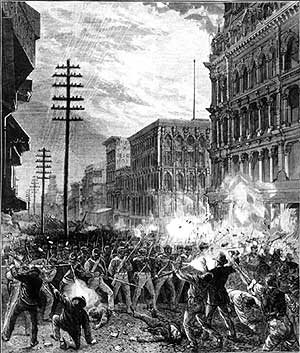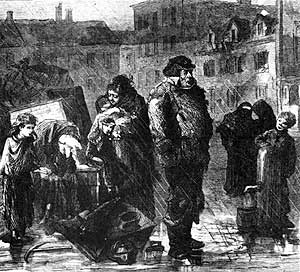Baltimore IMC : http://www.baltimoreimc.org
LOCAL Announcement :: Activism : Baltimore MD : Class : History : Labor : Protest Activity
REMINDER: Baltimore 1877 Uprising Tour & Rally July 20
July 20, 2004 Event:
Reminder of today's Tour and Rally in recognition of the Great Railroad (General) Strike of 1877, which was sparked in Baltimore, and spread across the country.
Reminder of today's Tour and Rally in recognition of the Great Railroad (General) Strike of 1877, which was sparked in Baltimore, and spread across the country.
.
REMINDER
.

.
* Tour and Rally Celebrating the Baltimore Rebellion of 1877! *
Tuesday July 20, 2004
4:30pm
At the 5th Regiment Armory, Howard St. & Preston St.
Mark the actions of the workers of Baltimore and the Nation over a century ago and learn about the conditions of workers currently being mistreated in Baltimore.
Synopsis of the Great Railroad Strike of 1877
"Fueled by government funds, railroad building boomed after Civil War. There were only 2,000 miles of track in 1850--by 1877 there were nearly 80,000 miles in use. Railroad owners controlled tens of thousands of employees and hundreds of millions of dollars in assets. Companies such as the Baltimore & Ohio Railroad bought coal mines, built iron mills, and consumed whole forests. Larger than some state governments, the railroads pioneered the form of the modern corporation." (2)
"From 1873 to 1878, America was struck by its first nationwide industrial depression. The depression began when railroad owner Jay Cooke was found to have issued millions of dollars of worthless stock. Investors panicked and banks closed. " (2)
During 1877, wages to rail road workers were cut several times. Baltimore & Ohio (B&O) brakemen's wages dropped from $70/month in 1873 to $30/month in 1887. (3) The Baltimore Sun wrote, "the story of their struggles to live is very sad,... Many of them declare they might as well starve without work as starve and work." (3)
Some cite the Baltimore Sun reporting as contributing to the uprising. The Sun reported on the earnings of the B&O, on July 15, 1877. B&O President Garrett reported profits to the board of directors noting that affairs were "entirely satsifactory." The board voted a 10 percent divided to stockholders. At the same time, the Sun reported 10 percent reductions in wages announced by Garrett. (3)
On July 16, the day wage cuts went into effect, the fireman on Engine 32 abandoned his train at Camden Junction (now Camden Yards), a critical point through which significant rail traffic had to pass. Other firemen followed suit, and Baltimore Mayor Latrobe ordered arrests. (3)
The strike spread down the rail lines to the West, with Martinsburg becoming "the second and more serious center of strike activity." Eventually, the strike spread to other cities including Pittsburg, Chicago, Cincinnati, and Reading. (3) The strike also included people from industries other than the rail road, and is cited as being the first general strike in the United States.

The Baltimore Sun reported "The singular part of the disturbance is the very active part taken by the women, who are the wives or mothers of the firemen. They looked famished and wild, and declare for starvation rather than have their people work for the reduced wages." (3)

"Railroad owners called the strikers "un-American," and spoke of liberty and property rights. Newspaper editors joined the attack. The National Republican blamed the strike on "Communism--a poison introduced into our social system by European laborers." Some editors recalled the "Paris Commune" of 1871, when the workers of Paris led a city-wide revolt and set up a new government." (2)
"Yet strikers thought they were defending America's heritage of equality and independence. Pointing to government funding for railroad construction, they claimed owners had betrayed the nation's trust for the sake of higher profits. "Capital has overridden the Constitution," said one St. Louis workingman. "Capital has changed liberty into serfdom, and we must fight or die."" (2)
General William Getty led the process of crushing the strike starting in Cumberland, MD. Three days of fighting were required to open the road between Keyser and Grafton. After about sixteen days on strike, workers began returning to the job, ending the B&O strike. (3)
William Keyser, of the B&O, blamed the strikers for the "innocent men and women shot down in our streets," and for "bloodshed in Chicago and Cincinnati, Reading and other prominent cities of the land." The Martinsburg Statesman placed the blame elsewhere, noting that the uprising should teach "heartless and selfish railway corporations that there is a point in oppression beyond which it is not safe to go." (3)
Notes:
(1) The Nation, July 26, 1877.
(2) web.gc.cuny.edu/ashp/1877
(3) The Great Labor Uprising of 1877, Philip Foner.
Other References
University of Pittsburg Library
Maryland Archives: Baltimore Railroad Strike of 1877
Contact for Baltimore 1877 Tour & Rally: Baltimore1877 (at) ziplip.com
REMINDER
.

"The great strike--The Sixth Maryland Regiment fighting its way through Baltimore," Harper's Weekly, August 11, 1877. July 20, 2004 Tour & Rally will remember this historic event.
.
* Tour and Rally Celebrating the Baltimore Rebellion of 1877! *
Tuesday July 20, 2004
4:30pm
At the 5th Regiment Armory, Howard St. & Preston St.
Mark the actions of the workers of Baltimore and the Nation over a century ago and learn about the conditions of workers currently being mistreated in Baltimore.
Synopsis of the Great Railroad Strike of 1877
"Fueled by government funds, railroad building boomed after Civil War. There were only 2,000 miles of track in 1850--by 1877 there were nearly 80,000 miles in use. Railroad owners controlled tens of thousands of employees and hundreds of millions of dollars in assets. Companies such as the Baltimore & Ohio Railroad bought coal mines, built iron mills, and consumed whole forests. Larger than some state governments, the railroads pioneered the form of the modern corporation." (2)
"From 1873 to 1878, America was struck by its first nationwide industrial depression. The depression began when railroad owner Jay Cooke was found to have issued millions of dollars of worthless stock. Investors panicked and banks closed. " (2)
During 1877, wages to rail road workers were cut several times. Baltimore & Ohio (B&O) brakemen's wages dropped from $70/month in 1873 to $30/month in 1887. (3) The Baltimore Sun wrote, "the story of their struggles to live is very sad,... Many of them declare they might as well starve without work as starve and work." (3)
Some cite the Baltimore Sun reporting as contributing to the uprising. The Sun reported on the earnings of the B&O, on July 15, 1877. B&O President Garrett reported profits to the board of directors noting that affairs were "entirely satsifactory." The board voted a 10 percent divided to stockholders. At the same time, the Sun reported 10 percent reductions in wages announced by Garrett. (3)
On July 16, the day wage cuts went into effect, the fireman on Engine 32 abandoned his train at Camden Junction (now Camden Yards), a critical point through which significant rail traffic had to pass. Other firemen followed suit, and Baltimore Mayor Latrobe ordered arrests. (3)
The strike spread down the rail lines to the West, with Martinsburg becoming "the second and more serious center of strike activity." Eventually, the strike spread to other cities including Pittsburg, Chicago, Cincinnati, and Reading. (3) The strike also included people from industries other than the rail road, and is cited as being the first general strike in the United States.
Click on image for a larger version

1877 Great Railroad Strike: People of Chicago said "enough" to the consolidated power and exploitation of the railroad corporations. Baltimore remembers this history with a Tour & Rally, July 20, 2004.
The Baltimore Sun reported "The singular part of the disturbance is the very active part taken by the women, who are the wives or mothers of the firemen. They looked famished and wild, and declare for starvation rather than have their people work for the reduced wages." (3)

1877: A poor family evicted from their home. A New York City paper reported: "Thousands of men and womewn are to be seen nightly sleeping in our public parks. . ."
"Railroad owners called the strikers "un-American," and spoke of liberty and property rights. Newspaper editors joined the attack. The National Republican blamed the strike on "Communism--a poison introduced into our social system by European laborers." Some editors recalled the "Paris Commune" of 1871, when the workers of Paris led a city-wide revolt and set up a new government." (2)
"Yet strikers thought they were defending America's heritage of equality and independence. Pointing to government funding for railroad construction, they claimed owners had betrayed the nation's trust for the sake of higher profits. "Capital has overridden the Constitution," said one St. Louis workingman. "Capital has changed liberty into serfdom, and we must fight or die."" (2)
General William Getty led the process of crushing the strike starting in Cumberland, MD. Three days of fighting were required to open the road between Keyser and Grafton. After about sixteen days on strike, workers began returning to the job, ending the B&O strike. (3)
William Keyser, of the B&O, blamed the strikers for the "innocent men and women shot down in our streets," and for "bloodshed in Chicago and Cincinnati, Reading and other prominent cities of the land." The Martinsburg Statesman placed the blame elsewhere, noting that the uprising should teach "heartless and selfish railway corporations that there is a point in oppression beyond which it is not safe to go." (3)
Notes:
(1) The Nation, July 26, 1877.
(2) web.gc.cuny.edu/ashp/1877
(3) The Great Labor Uprising of 1877, Philip Foner.
Other References
University of Pittsburg Library
Maryland Archives: Baltimore Railroad Strike of 1877
Contact for Baltimore 1877 Tour & Rally: Baltimore1877 (at) ziplip.com
Views
Information
Search
This site made manifest by dadaIMC software

